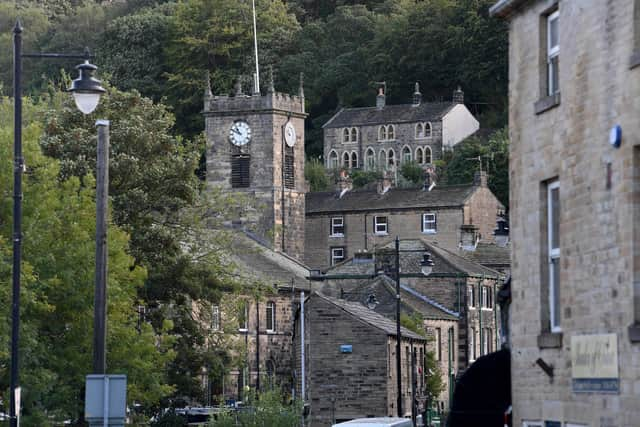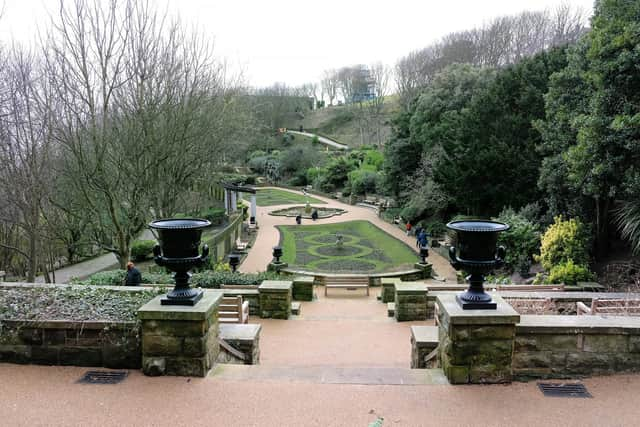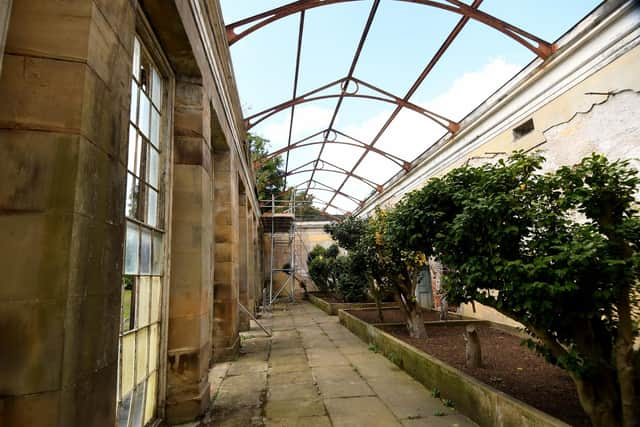Heritage at Risk Register 2023: Camellia House at Wentworth Woodhouse, South Cliff Gardens in Scarborough and Holmfirth town centre all saved - but concern over Cannon Hall's crumbling kitchen garden
Historic England has confirmed that the Camellia House on the Wentworth Woodhouse estate near Rotherham, the South Cliff Gardens in Scarborough, and the Conservation Area in Holmfirth town centre are no longer monuments of concern.
The Wentworth Woodhoue Preservation Trust’s gardeners rescued a number of 18th-century camellias imported from Asia that are thought to be some of the oldest specimens in the UK as part of the restoration of the Grade I-listed former teahouse and menagerie. The plants had been neglected for decades and the building’s roof had collapsed, but they will now form the focal point of a new cafe and events space for visitors.
Advertisement
Hide AdAdvertisement
Hide AdScarborough Council led the revival of the South Cliff Gardens, once one of the resort town’s main attractions and a place to ‘promenade’ in the Edwardian age. Several local dignitaries donated clifftop land to form a series of gardens that later became publicly owned, but over time they had deteriorated. Funding grants enabled paths and shelters to be repaired, drainage improved and a tunnel beneath the Spa re-opened.


A major effort to revitalise Holmfirth town centre by encouraging independent businesses and preserving its textile heritage has also reaped results, with the area now firmly back on the tourist trail after fears over empty shops.
Yet seven buildings and sites have been added to the 2023 list because they are at risk of neglect, decay or inappropriate development. There is concern about the kitchen garden at Barnsley Council-owned stately home Cannon Hall, despite restoration work, because a section of the north wall has collapsed.
Historic England’s regional director for Yorkshire Tom Frater said: “Protecting our heritage in Yorkshire is so important. It is truly inspirational to see communities in the region coming together to save historic places and find new uses for them. The Heritage at Risk programme shines a light on our most in-need historic sites, and has a record of attracting funding and practical help. After a quarter of a century of the Heritage at Risk Register, we are celebrating the many places that have been saved, as we continue to find new ways to involve local people in caring for and enjoying their heritage."
SAVED


Holmfirth Conservation Area
Advertisement
Hide AdAdvertisement
Hide AdThe small West Yorkshire mill town of Holmfirth is best known as the home of comedy series Last of the Summer Wine, which ran from 1973 to 2010 and celebrates its 50th anniversary this year.
Holmfirth Conservation Area is characterised by its collection of former mills, dyeworks and weavers’ cottages. The River Holme runs through its centre.
The Conservation Area was put on the Heritage at Risk Register in 2009, owing to economic decline which led to many retail and commercial premises in the town becoming vacant and, in some cases, derelict.


In 2015, local residents formed the Holmfirth Conservation Group, with the aim of addressing some of the problems facing the town and securing the removal of Holmfirth from the Heritage at Risk Register. To this end, they undertook a comprehensive survey of Holmfirth which created the evidence base required to develop a plan of action.
Advertisement
Hide AdAdvertisement
Hide AdIn the past few years, the local economy has improved, vacancy rates have fallen and buildings have been sympathetically repaired and repurposed. As well as continuing to attract fans of Last of the Summer Wine, Holmfirth has developed a vibrant cultural scene, centred on Holmfirth Picturedrome, with a thriving programme of festivals and events throughout the year.
South Cliff Gardens, Scarborough
South Cliff Gardens comprises a series of coastal paths and ornate gardens, as well as handsome architecture including shelters, summerhouses and the Holbeck Clock Tower. Developed from the mid-19th century to the 1930s, several notable landscape architects help to shape the gardens including Sir Joseph Paxton who designed the grand Italian Steps, where Victorian ladies and gentlemen would gather for a genteel stroll in their finest attire.
Sadly, coastal erosion and the general deterioration of its condition led to the Gardens’ addition to the Heritage at Risk Register in 2013.
Thanks to the efforts of the Friends of South Cliff Gardens and Scarborough Council (now North Yorkshire Council), together with funding from the National Lottery Heritage Fund and the National Lottery Community Fund, the Gardens underwent an extensive two-year £7million restoration project.
The Camellia House, Wentworth Woodhouse, Rotherham
Advertisement
Hide AdAdvertisement
Hide AdThe Camellia House is an early 19th-century conservatory created from a teahouse originally built for Lady Rockingham, wife of the 1st Marquess, in 1738 to entertain and impress her guests. By 2017, when Wentworth Woodhouse Preservation Trust took over, the building was derelict and roofless.
Its camellias, exposed to the elements for decades, were found to include plants dating from the early 1800s - some of the oldest in the Western world.
Last summer, a year-long project funded by Historic England and the National Lottery Heritage Fund was carried out to repair and transform the Camellia House into a public tearoom, protecting the historic blooms throughout. The Camellia House opens in spring 2024.
Sheffield General Cemetery
Sheffield General Cemetery was opened in 1836 in response to overcrowding and poor conditions in Sheffield’s churchyards, exacerbated by a cholera epidemic in 1832.
Advertisement
Hide AdAdvertisement
Hide AdOne of Britain’s earliest commercial garden cemeteries, designed by the celebrated horticulturist Robert Marnock, the site became the main burial ground in Victorian Sheffield, containing the graves of 87,000 people.
The site is architecturally rich, boasting 10 listed buildings and monuments including catacombs, chapels and the ornate Grade II* listed Egyptian Gate. It was closed for burials in the late 1970s and became a much-loved greenspace for both people and wildlife.
However, over the years, the state of the cemetery declined; many of the buildings fell into disrepair and the site became a target for anti-social behaviour. Sheffield General Cemetery Trust, the organisation originally set up by local residents almost 35 years ago, set about the enormous task of bringing the cemetery back from dereliction by restoring the Samuel Worth Chapel and the Sexton’s Cottage, running community activities such guided tours and workshops, as well as historical research.
In 2018, The National Lottery Heritage Fund and The National Lottery Community Fund’s Parks for People programme awarded Sheffield City Council £3m to fund a major programme of repair, conservation works and community engagement. The project came to an end in 2023.
Church of St Martin, Main Street, Seamer, Scarborough
Church of St Mary, Church Lane, Mirfield
Advertisement
Hide AdAdvertisement
Hide AdHorn Ridge cross dyke, cairnfield, round cairn and prehistoric hut circles, Farndale West
Earth circles, cursus, pit alignments and burial sites near Nosterfield and Thornborough, including Centre Hill round barrow, West Tanfield
Mytholmroyd Conservation Area, Calderdale
Round barrow north of manor house, Thixendale
Hunslet Mill, Leeds
Church of St Augustine, Hyde Park Road, Leeds
ADDED
Cannon Hall kitchen garden wall, Barnsley
Cannon Hall’s kitchen garden was constructed in 1760 and forms part of the Grade II-listed park and garden.. The kitchen garden is surrounded by a handmade red brick wall lined with fruit trees, some of which date from the 18th century. It has a path around its perimeter and contains numerous garden buildings within it including gardeners’ cottages, glasshouses, and tool stores. The garden is open to the public and welcomes hundreds of thousands of visitors each year.
There has been substantial investment in the repair and maintenance in the gardens in recent years which has transformed this much-loved place, protecting it for generations to come. However, the site has gone on to the Heritage at Risk Register as a large section of the north kitchen garden wall is at risk of collapsing onto the path and has had to be fenced off. The custodians, Barnsley Museums, have developed a repair scheme for the wall but this has yet to be implemented due to financial pressures.
Advertisement
Hide AdAdvertisement
Hide AdCropton Hall Garth - a motte and bailey castle including later medieval manor house, a medieval trackway and a pond, near Pickering in North Yorkshire
Round barrows and entrenchments on Egton High Moor, Egton, North Yorkshire
Roppa South Cross on Carr Cote Ridge, Helmsley, North Yorkshire
Station Road Conservation Area, Batley
Bridge and medieval gateway at Walton Hall, Walton, Wakefield
Round barrow on Wheeldale Moor, 1150 metres west of Wheeldale Lodge, Egton, North Yorkshire
